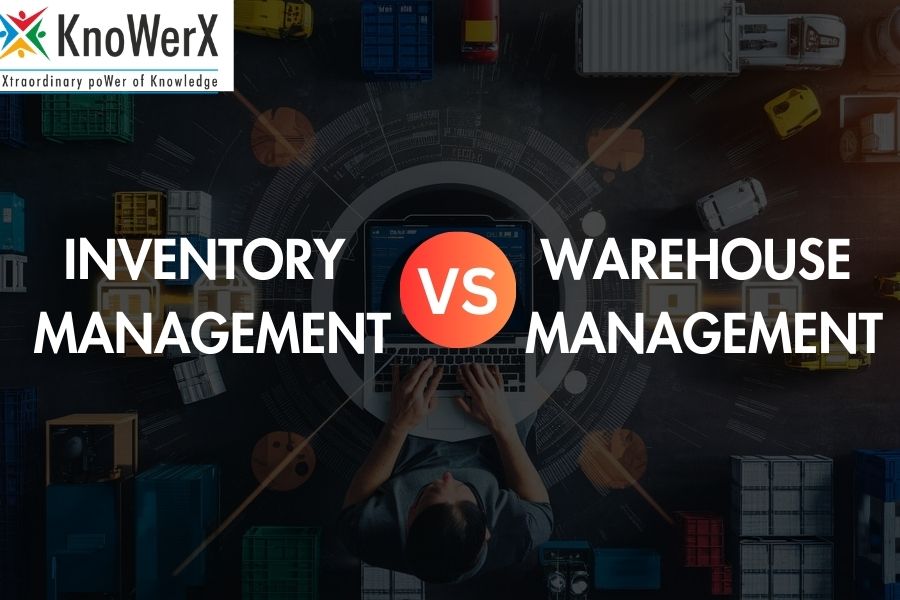Inventory Management vs. Warehouse Management

Inventory Management vs. Warehouse Management: What is the Difference? Any organization has to be concerned with the movement and storage of goods. From a supply chain perspective, warehouse management and inventory management are considered the most integral parts. While they sound similar, they are actually pretty different in what they can do to keep the operations running smoothly. In this article, we explore the difference between warehouse management and inventory management, their responsibilities, benefits, and why it’s crucial to have an integrated system between these two. Understand the concept of warehouse management. The warehouse management refers to a way of storage and mobilization of goods around the facility. It looks at placing the correct product in its particular space, followed by proper tracking of merchandise when it both enters and leaves the building, so everything falls into place for maximum efficiency. Responsibilities of the key elements of warehouse management include: Storage area management and space optimization. Tracking of product for its correct position for easy access. They also ensure that the order is timely and correct to reach customers. Benefits of using Warehouse Management 1. Improved Efficiency: The well-organized warehouse, therefore makes sure that the orders are processed and shipped out much faster with the least delay to improve customer satisfaction. Better Accommodation of Space: Effective management of the warehouse by business ensures full utilization of the availed space with minimal or no wastage besides maintaining low storage costs. Fewer Errors: When products are stored and tracked properly, fewer picking and packing errors are made when processing the order. These, in turn, lead to fewer returns and customer complaints. Understand the concept of Inventory Management On the other hand, inventory management will entail monitoring of the inventory levels so that there is an accurate quantity at the proper time. It concerns coordinating supply and demand so that stock is sufficient to meet customers’ demand without overstocking. Responsibilities of inventory management consist of: Keeping track of stock levels so products are available if and when needed Demand forecasting to help estimate how much stock to purchase. Replenishment when the level of inventory falls to a point at which there is no risk of a stockout. Benefits of Inventory Management Improved Cash Flow: By not overstocking items, businesses can free-up capital to use elsewhere in their enterprises. In the same vein, by not stocking out, they ensure that they do not lose out on revenues. Accurate Demand Forecasting: Efficient inventory management helps business entities foresee future demand for their products and lessens risks related to overstocking or understocking of their goods. Multiline Waste Minimizing: Inventory management enables enterprises operating with perishable goods not to get into situations when goods are staying for an extended period in storage and then spoil. Inventory Management vs. Warehouse Management Although both are interlinked with very close relations, warehouse management and inventory management differ in focus and responsibilities. The difference between them, which is fundamental to optimization, is thus explained. Scope and Focus: Warehouse Management: In this regard, the management focuses on the physical space the products are kept in, making sure that movement in and out of the warehouse is fluid. Inventory Management: This addresses the actual stock-how much of each of the products is in stock and maintaining appropriate balances between supply and demand. Technology and Systems: Warehouse Management: Very often, this involves the use of Warehouse Management Systems to assist in maximizing storage space, tracking the location of a product, and managing orders. Inventory Management: Inventory Management Systems monitor levels of stock, predicted demand, and automatic reordering. Role in the Supply Chain: Warehouse Management: Directly affects the efficiency level of the order processing procedure in which products are held for dispatch in the minimum length of time. Inventory Management: Deals with procuring and maintaining the stock of items in a proper way so that the business always has enough inventory to fulfill customer requirements. Benefits of Integrating Warehouse and Inventory Management The integration of the warehouse with inventory management makes for smooth running operations. This shall be beneficial in the following ways: Efficiency Enhancement: When the two systems are integrated, it means that the operation or running of activities is smooth; hence, there will be minimal errors and a quickening of the processes. Full Visibility: Since the systems are integrated, there is real-time information on stock and warehouse activities, thus providing a full view of operations. Informed Decision Making: Accurate data on hand helps businesses make conscious decisions-from ordering new stock to reorganizing the warehouse for better efficiency. FAQs: Frequently Asked Questions End Notes At KnoWerX, we emphasize that knowing the difference between warehouse management and inventory management forms one of the key bases upon which businesses can actually optimize their supply chain. Our CIMO (Certified Inventory Management Officer) and CWMP (Certified Warehouse Management Professional) programs provide comprehensive knowledge in both fields. While warehouse management concerns the physical storage and moving of goods, inventory management ensures that the stock is accurately tracked and available. This integration will, therefore, enhance business operations by cutting costs and improving customer satisfaction, which eventually reflects better overall efficiency in the supply chain management. Image Reference: Freepik Disclaimer: All trademarks, logos, and brand names are the property of their respective owners. All company, product, and service names used in this website are for identification purposes only. Use of these names, trademarks, and brands does not imply endorsement.
